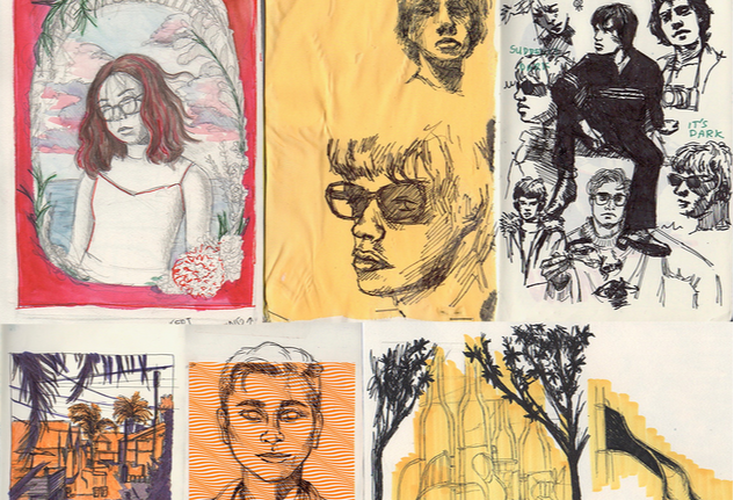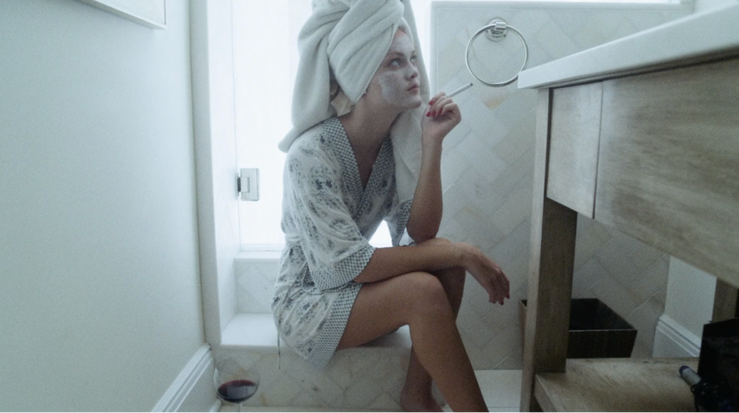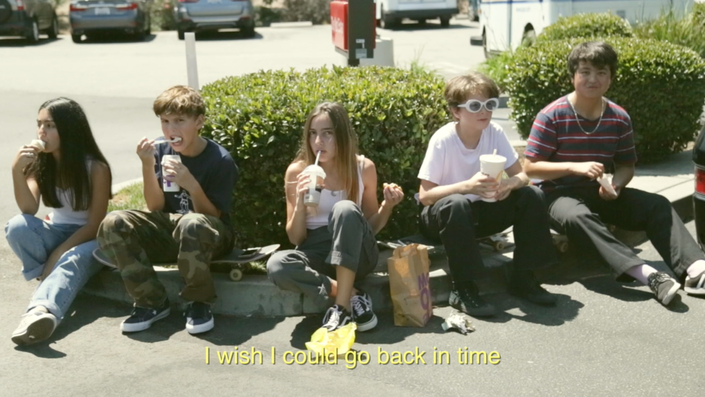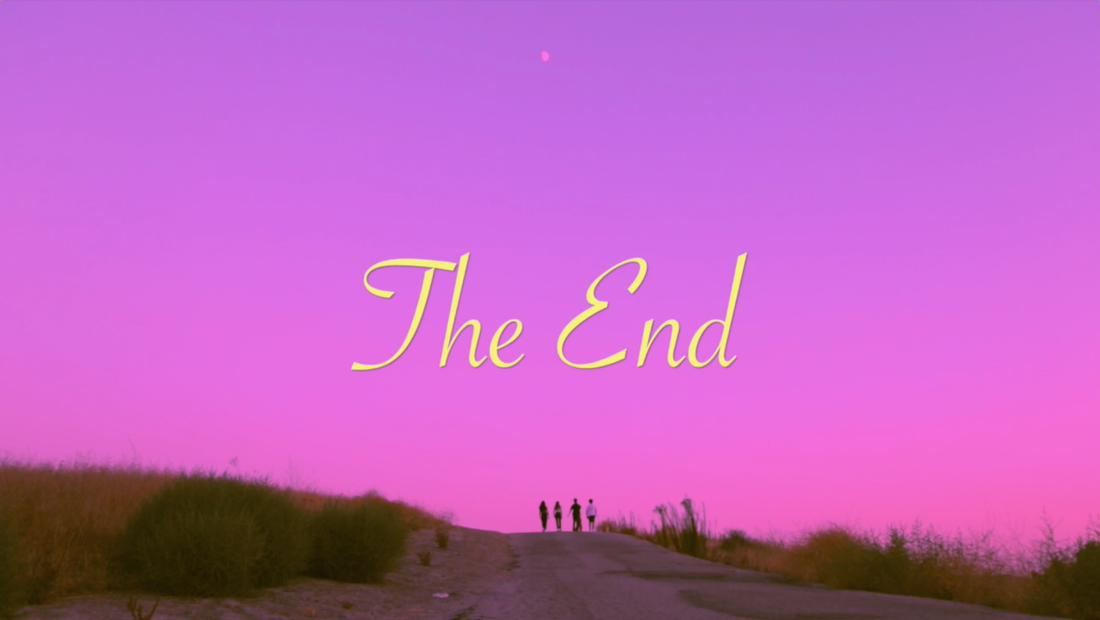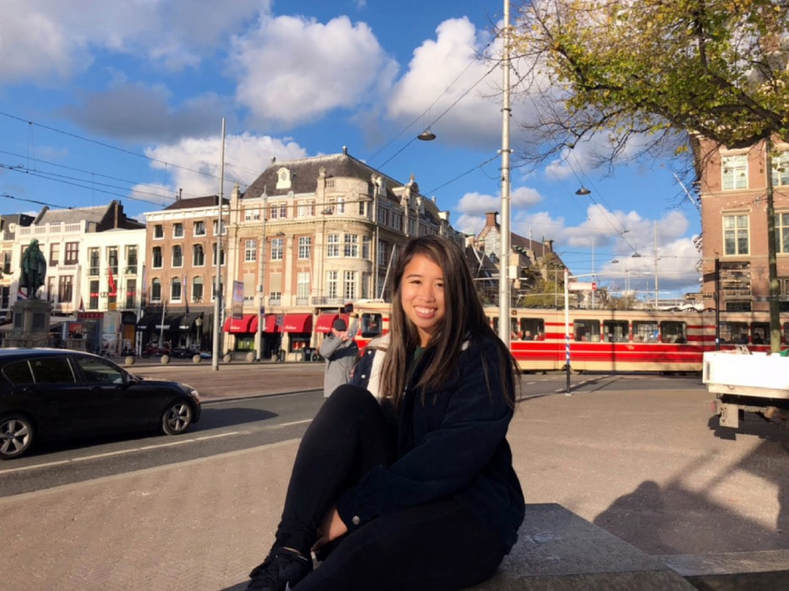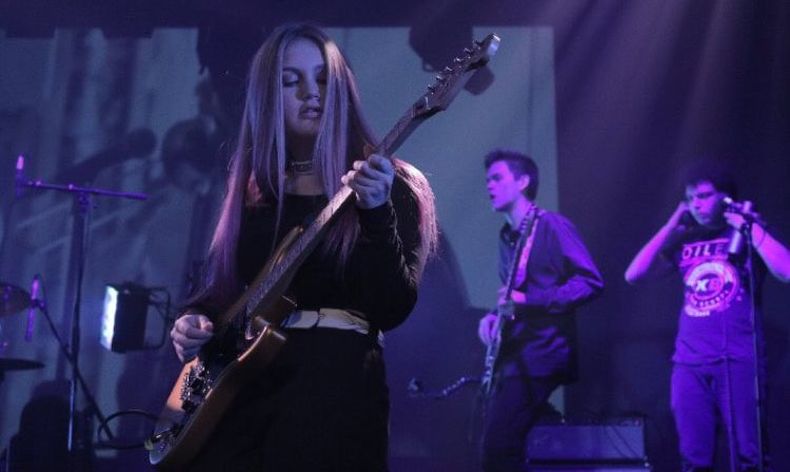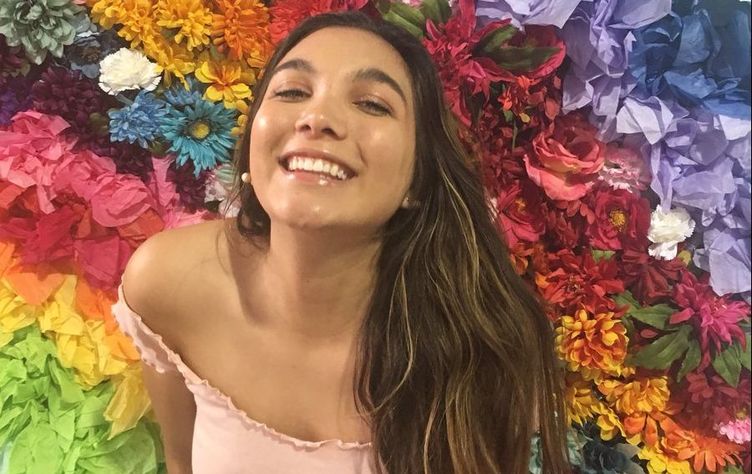|
The Heart2Art Project’s Gillian Rule interviewed Remi Frolichman, a 17 year old artist attending the Orange County School of the Arts about her artistic expression and what the youth have to offer the artistic world. Here’s what she had to say: 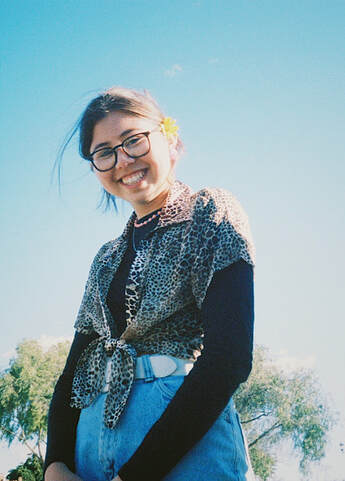 GR: What is your passion and when did it begin? How did it develop and grow throughout your life? RF: My passion for art has been around for as long as I can remember. I’m told it began with drawings on MagnaDoodles - then it evolved into oil painting, and now ranges from painting, photography, to graphic design. GR: How do you express yourself creatively? What mediums do you use? RF: Aside from, and more frequently than visual arts, I express myself through my apparel. For a while I’ve valued the expressive side of clothing - it’s something that’s new every day so I prioritize having fun with my clothing as almost an artistic medium in a commitment-free/transient way. I express myself through music, as well - I can sort of play a few instruments and I’ve written a little, in a hobby type of way. Whether it’s playing or creating playlists, music is huge in my life and I’d consider it some way I express myself. GR: Where do you draw your inspiration from? Is there a particular artist that you find inspirational? RF: Artists Ignasi Monreal and Delfin Finley make up my top inspirations in art. I’m constantly inspired by their detailed work and who they create for. Also Sari Shryack and Kehinde Wiley [inspire me]. A very large portion of my inspiration also comes from the people and work I encounter at school. 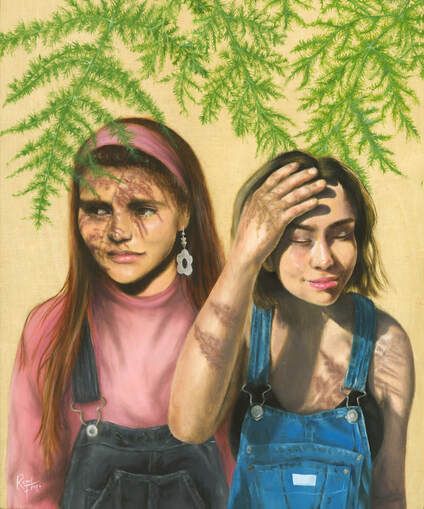 GR: Aside from visual artists, are there any artists in music, film, or other mediums that have inspired you as well? RF: I’m often inspired by the work of musical artists, the music, the writing, and the visuals. Specifically artists like Tipling Rock, Steve Lacy, and Half Alive. My favorite fashion designer/creative director is Alessandro Michele who leads all the beautiful ideas portrayed by Gucci. GR: What kinds of obstacles did you face in pursuing the arts, either as a hobby or career? Did you have any supporters along the way? RF: Though I think it’s gotten better, there’s still a stigma around pursuing art. I’ve felt some subtle influences of this stigma, however I’m very fortunate to have strong supporters of my artistic path. GR: You go to an art school. How has being in an art school enhanced your creative expression? RF: Going to an art school for so many years has really shaped myself as an artist. Since 7th grade i’ve been immersed in a school where I’m constantly surrounded by talented artists. I immediately found that this could make it easy to fall into a pool of comparison, so i feel that this environment allowed me to prioritize strengthening my own originality. On top of this, the friendly competition as a result of the concentrated talent provides a source of motivation to create and advance my work. 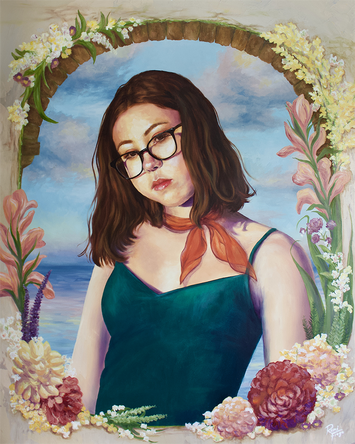 GR: While more spotlight is being brought to the voices of our generation in recent years, history has shown that the perspectives, activism, and art of teenagers are often dismissed. Have you personally experienced this as a teenager? RF: I have definitely felt the effects of dismissive comments regarding my art, but I think more so than the comments, I place the dismissal on myself. I often find myself devaluing what I do, almost regardless of what people say - that people won’t want to purchase my pieces or will take my work/practice less seriously due to my lack in experience or young age. So I think it’s the climate that surrounds the overlooking of teen voices that can affect how teens view themselves. GR: What does the youth have to offer to the world (whether this means perspective-wise, activism-wise, the sharing of art, etc.) and why is it important that this is recognized? RF: Youth today can offer open minds. Though mindsets aren’t unanimous, openness to change is something more prevalent in the newer generations. I think it’s important to recognize that the future can diverge from the past and today’s teens can understand that what we live in depends on what we spread as individuals. GR: Do you have a favorite piece that you have created? Can you explain it and why it is your favorite? RF: My favorite piece is a self portrait I completed in December 2018. It’s a manifestation of the week I spent in Italy. The composition, posture, and expression were inspired by Renaissance portraits I saw in Florence; the curved border from the repeated architectural style; the flowers and greenery from the agriculture. This trip gave me a significant new perspective on the world, outside of the bubble of my own region. Consequently, I thought it best to create a piece representing what I saw, but also how I felt during/after the trip. I consider this piece my favorite because I felt more conceptually driven during the process than in that of any others, so I have a much stronger connection to it. 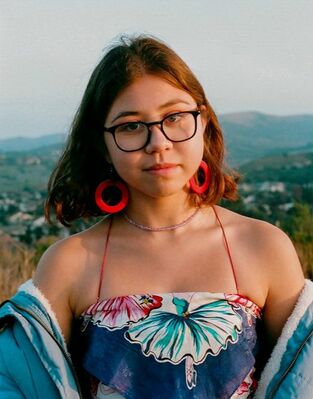 GR: How would you explain being a teen artist in comparison to being from an older generation? RF: Exposure is different! It’s obvious that with the advancement of all types of social media networks it’s extremely easy to get your work out there. But this has its ups and downs. Like, your work, it’s out there, but in an ocean of everyone else’s as well. I also think there’s more freedom in what’s considered art today, which allows more people to create what they want and get recognized for it. GR: Do you feel like your art is representative of your experiences as a teenager? As you get older, do you think that your artistic style will change? RF: Throughout my teen years my work has included depictions of my friends and photos I’ve taken. I don’t think my pieces directly tell the audience the stories of my experiences, but more so give a snapshot of something I find significant. When I look at my work I can see the arc of my skill and the transition of my interests and inspirations. I think my style will keep a lot of the same aspects but I’ll continue to develop it as I explore many more subject matters, techniques, and mediums. GR: Any last words or advice you would like to share? RF: Explore, let your confidence radiate, ‘make an enemy of envy’ (Jerry Saltz), find those who inspire you and keep them around. Follow Remi! Instagram: @remifrogo Gillian Rule VP of Social Media + VP of Communications + VP of Publications @gillianrule
0 Comments
The Heart2Art team kicked off our upcoming series of interviews with various teen artists with Olivia Ooms, a 16-year-old singer and songwriter from Southern California. We visited the aspiring country artist to talk about her work, her passions, and where she hopes to be in the future.
Interviewee: Olivia Ooms Director/Editor: Caitlyn Phu Cinematographer: Grace Larey Teaser Trailer for Gracie Bellissimo's 2017 documentary short film "Indie Kids" 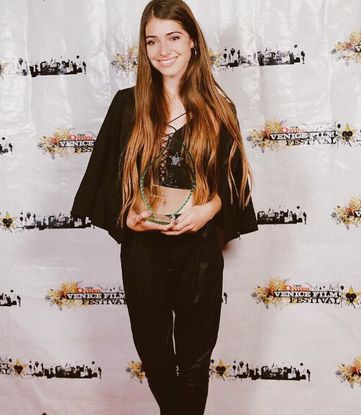 I recently had the opportunity to interview 19 year-old Gracie Bellissimo, an aspiring filmmaker, on her experience as a teen in the arts. Raised in Los Angeles, Gracie is currently working towards furthering her film portfolio and experience as she enters college studying film. Touching on subjects from her love for Lorde to her incredible internship opportunities, Gracie shared with me her journey thus far: Caitlyn Phu: What is your passion and when did it begin? How did it develop and grow throughout your life? Gracie Bellissimo: When I was just four years old, I watched a “Barbie Goes Hollywood” movie and that’s when I realized that making movies was actually a job that someone could have. It seemed so fun to me that I didn’t even think it was something you could get paid for... I still sometimes can’t believe it. From there, I thought I wanted to be an actress, but I grew up writing and directing my own plays that my little sisters would star in. I would act in them as well on top of basically putting on all the little productions. I eventually got a hold of my dad’s handheld camcorder and started making mini movies on it using barbies or littlest pet shops. When I was 6 or 7, I somehow taught myself how to edit these mini-movies on iMovie. I honestly don’t know how I just figured it out without any instruction but it felt very natural to me and it was pretty much one of my favorite ways to spend my free time. Once I reached middle school, I had done over 40 musicals in my community theater...so I still thought I wanted to do acting. One day in eighth grade, I decided to shoot and edit a youtube video of how to make a Tumblr-inspired notebook collage. I was literally just bored one day and put it up for fun, but the video racked up a ton of views, so I posted a few more. I didn’t really see myself as a Youtuber though so I stopped for a while, but then Colleen Ballinger (AKA Miranda Sings) gave my channel a 2-second shoutout in one of her videos, without even linking my channel, and a ton of people still went and watched it/subscribed. Before I knew it, I had nearly 30K subscribers and demand for content was high, so I made youtube videos for a while until it finally wore on me and I realized it was not fulfilling my true passion: Cinema. I stopped posting youtube videos and by that time, I was at the end of my sophomore year of high school. For junior and senior year, I joined an incredibly immersive film program, where I made some of the greatest friends I’ve ever had. It didn’t teach me as much as I hoped it would about film, however, so I started making a ton of short films on my own time outside of class so that I could have a portfolio when applying to colleges. A handful of my short films were accepted into international film festivals, and I also had made my own connections through social media and got to remote intern for Lucy Tcherniak (Director of The End of the Fucking World) and also shadowed at Paramount Studios my summer entering senior year, which led me to shadowing and assisting Elizabeth Allen Rosenbaum with her upcoming show (the Pretty Little Liars spin-off), The Perfectionists. I did my first semester of college in Brooklyn, New York, but I quickly discovered that the east coast isn’t for me. Now I am studying Cinema at San Francisco State University and am very excited to continue creating my own short films and music videos. 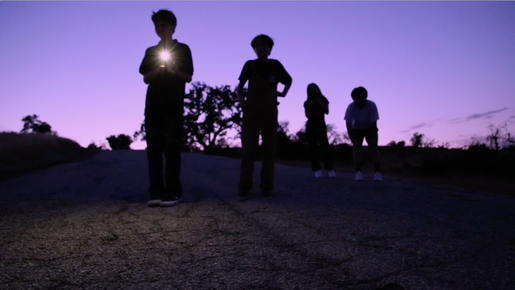 CP: How do you express yourself creatively? What mediums do you use? GB: I love creating my own short films, but I also have a lowkey passion for music. Whenever I am stressed, I either listen to music or write my own songs. I feel that writing music is my fastest, most honest and fulfilling way of getting things off my chest. I have horrible stage fright, however, even after growing up in the theater, because I hate singing in front of others, so it’s more of a personal release through art. I have considered recording an EP, so maybe that can be expected in the future. Back to film, I use film to express experiences I have either observed, experienced myself, or randomly thought of in a daydream. They usually focus on a specific theme or message. This past year, I have also been dabbling in 35 & 50mm photography. I carry either a disposable camera, my point-and-shoot, or my Canon AE1 wherever I go. I do this simply as a hobby and because of my love for the visual arts. Film photography has been a dying art form, but I love it because it’s honest in the sense that it is untouched and captures a moment raw, something we don’t see very much in an often facetuned/Instagram world. I also love the excitement of waiting to get your photos developed because every time...your roll is a mystery and there are always exciting or even disappointing surprises (I've shot a few blank rolls hahaha...still learning!) CP: Where do you draw your inspiration from? Is there a particular artist that you find inspirational? GB: I have always looked up to Lorde as my inspiration, mainly for film, but also for music. I just think it’s so inspiring that she was able to accomplish so much at such an early age. She has driven and inspired me to create honest art with hints of teenage nostalgia, and also inspired me to not let my age affect the opportunities I have worked hard to obtain (Paramount, internships with directors, etc). I even made my senior project a seven-minute video that abstractly tells the story of my high school life soundtracked by Lorde’s songs because they perfectly encapture how I felt in every stage of high school. She really changed my life and opened a whole new world to me as an artist. I can still remember the first time I heard “Royals” before any other songs of hers came out. I was only in middle school, and I knew that this girl, although only a few years older than me, was going to shape the way music today is made (I could write a book on why Pure Heroine inspired like 80% of the music we hear today haha). But basically, Lorde showed me that age shouldn’t ever stop you from pursuing your dreams as an artist and that doing something totally “out there” may actually become revolutionary. Another fan of Lorde’s was David Bowie, who even called her “The future of music”. I look to him as a prime example of variety. He was an ever-changing artist, always experimenting with different genres, which is something I long to do in film. 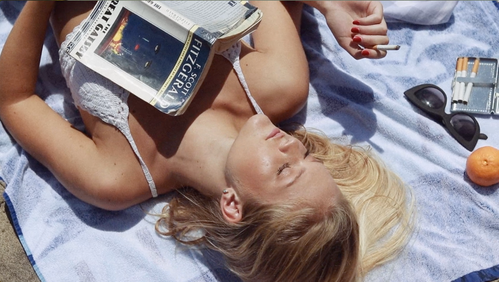 CP: What kinds of obstacles did you face in pursuing the arts, either as a hobby or career? Did you have any supporters along the way? GB: I think a lot of people underestimate my visions I have for future projects because A). I am still a teenager and B). I am a girl. I’ve been writing a very complex pilot inspired by real events and I intend to bring it around to multiple producers/production agencies, but I am super nervous they won’t listen to me because of my age or that they may take advantage of my work because they may see me as a naive, young girl. Through it all, my parents have been my #1 supporters from day one. Growing up, they provided so much love and encouragement when it came to my sister’s and my own passions. They let me use their cameras (until they eventually let me buy my own), and my dad always jokes that I was the only 12-year-old in the world to ask for a boom mic for Christmas! Music-wise, I have literally been to countless concerts because of them. They see concerts as “inspiring” rather than indulgence. CP: While more spotlight is being brought to the voices of our generation in recent years, history has shown that the perspectives, activism, and art of teenagers are often dismissed. Have you personally experienced this as a teenager? GB: Absolutely. I think the film industry is an especially difficult art industry because there is so much business involved in it, and businessmen usually tend to dismiss young girls with seemingly vague dreams of being a director. However, I have also found some people to be very supportive of me and my vision, such as Lucy Tcherniak, Elizabeth Allen Rosenbaum, Clay Pecorin, and exec. producer Peter Lenkov. They all let me shadow one or more aspects of their work and some have allowed me to assist/basically intern for them. Because they gave me these opportunities at such a young age, they only opened more doors for me and have allowed me to make meaningful connections before I even graduated high school. I am so grateful that even though I am young, they saw a bit of their own younger selves and me and gave me a shot, which apparently doesn’t happen often in Hollywood. If I ever make it, I definitely will do the same for teenagers. 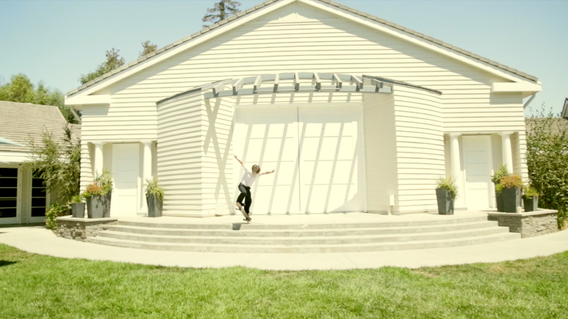 CP: What does the youth have to offer to the world (whether this means perspective-wise, activism-wise, the sharing of art, etc.) and why is it important that this is recognized? GB: We are the youth! We are young! We have fresh ideas! We aren’t afraid to say what we believe because we all start seeing ourselves as independent people around this time, and being able to speak your mind and share your thoughts with the world is so exciting and often inspiring for others. It’s important for us to speak up because the future of the world will ultimately be up to our generation, so it’s up to us to change things for the better or let things gradually get worse. CP: Why do you make art? GB:From a very early age, I have loved telling stories. Using film as a medium to tell interesting stories or spread important ideas to me holds more depth and contains more layers than photography for instance because so many people come together and use their talents to create one, beautiful piece of art together that ultimately can entertain, bring happiness to, or provoke the thoughts of audiences. CP: Do you have a favorite piece that you have created? Can you explain it and why it is your favorite? GB: I think that one of my favorite short films I have made is Indie Kids. It’s a completely improvised mini-documentary, and I love it because it was such a wholesome experience. One day, I wanted to test out some new color grading techniques, so I asked my youngest sister, Marlie, if I could follow her and her adorable/artsy friends around for the day. Tying this back to the aspect of the voices of the youth, I loved making this because I found their worldviews all to be very independent, interesting, and adorable. Also, they skate and listen to good music and dress well! In seventh grade I was a theater nerd in a Christian school, listening to just the top 40 until my eventual discovery of Lorde and Lana Del Rey turned me a bit more normal (hahahaha I’m so glad I was normal in middle school though because now a lot of other seventh graders care wayyyy too much about who they are/how they look because of social media). CP: Do you feel like your art is representative of your experiences as a teenager? As you get older, do you think that your artistic style will change? GB: My favorite genre of film are coming of age movies. I love the honesty and electricity of teenagers, how we all have this crazy blend of carelessness and caring a little too much. That’s what I love so much about Lorde...she perfectly captures the teenage experience in Pure Heroine, as well as the whirlwind of transitioning into adulthood on Melodrama. I think that is something I strive to accomplish, capturing teenagers accurately and creatively on camera in an emotionally moving, original story. Movies like The Perks of Being a Wallflower, Ladybird, Kings of Summer, and Moonrise Kingdom are some of my absolute favorites of all time, paying homage to youth without many over the overdone cliches. CP: How do you plan on pursuing your passion in the future, whether this be college or career-wise? GB: Throughout college, I am excited to collaborate with people my age on projects while delving deeper into learning about the art of cinema at SFSU. This summer, I hope to work on some sort of studio lot or film set. Looking forward, I understand that I am going to have to work incredibly hard to one day earn a higher ranking in the film industry, and I know that everyone either starts in the mail room or as a PA, so I am more than excited to take on those smaller jobs in hopes of eventually proving myself and working my way up. CP: Any last words or advice you would like to share? GB: In today’s day and age, we have so many platforms available to be able to make crucial business connections for future projects, and more importantly, a variety of places to share our work with the world and get it in front of as many people as we can. This is an exciting time for filmmakers especially, with video cameras being built into even our cell phones while current directors had to grow up using costly and complicated Super 8 film cameras. Still, I would love to own a super 8 camera! I miss seeing actual FILM on the big screen, I personally love the visual aesthetic/honesty of it more than digital work. See more of Gracie's work! Instagram: @graciebellissimo Website: graciebellissimo.com Caitlyn PhuPresident + Editor-in-Chief The Heart2Art Project's Gillian Rule interviewed Sammie Serrano, a 17 year senior in high school living in Huntington Beach, about her experience with her own cultural identity. Here's what she had to say: 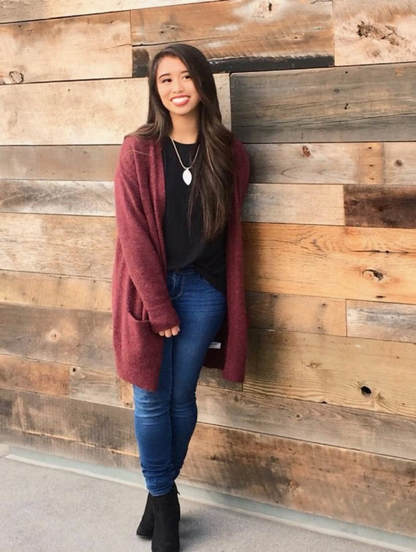 Gillian Rule: What is your cultural background? Sammie Serrano: Ethnically, I am Filipino. Both my parents are Filipino. My mom moved from the capital of the Philippines to the states in Cerritos when she was ten years old. She still speaks Tagalog (Filipino language), but she has no accent. My dad grew up in southern California in San Diego, but his parents are from a province in the Philippines called “Batangas.” He used to be able to speak Tagalog when he was really little, but he can only understand it now. However they both grew up in cities where there is a very high concentration of Filipinos, hence they were surrounded by the culture a lot more than I was. GR: What does cultural expression mean to you? SS: To me, it means to feel proud to hail from whatever nationality you were blessed to be, in spite of historical or stereotypical fallacies. It doesn’t necessarily mean wearing traditional clothing all the time as a fashion statement, at least to me (because at least we know that they’re only worn during special occasions like birthdays or weddings). I would personally know what that’s like because the Philippines is currently ruled by a drug cartel overlord trying to deal with an ISIS-inspired terrorist group in the southernmost mainland region. I know that not everyone necessarily knows this since not everyone keeps up with international politics, but it’s still hard knowing that this is the main issue that most political news outlets in the US tend to display. Nonetheless, Filipinos are proud as a culture. We know that whatever anyone thinks of us, only we know how fun it really is to be part of such a communal culture. We wear the Filipino name proudly, even if people are only half Filipino. GR: Have you ever felt out of touch with the culture that you grew up in or identify with? SS: Yeah, mostly because I grew up in Huntington Beach where there’s not really a lot of Filipinos. There was once a small Filipino restaurant in HB, but it didn’t last very long because there’s just not enough Filipinos that live in HB. If you wanted good Filipino food, you would just go anywhere in Cerritos or San Diego, but that’s a bit of a drive. The only times I really felt in touch with my culture was when I was surrounded by other Filipinos at family parties or even shopping at seafood city, the commissary, manila sunset, or other Filipino supermarkets and restaurants where I can recognize the language. Even though I have some friends who happen to be Filipino, it’s funny how the main reason we get along is that we simply are Filipino. Although my mom speaks Tagalog, I never was able to learn the language. I do know some miscellaneous words, but I still wish I was able to speak it fluently. GR: What aspects of your culture do you particularly admire or appreciate? SS: Where do I even start... The most prominent way that we show our love to others is through food. We tend to make a surplus of food for guests because we’re paranoid about having enough for everyone, even if just one person is coming over. I feel most in touch with my culture when I go to any family gathering, because no matter the occasion, whether someone turned a year and a half years old or someone just got engaged or even if someone just died, there’s always going to be a surplus of food waiting for you in the kitchen. At these parties, because we over make so much food, there is literally a word in Tagalog that refers to the leftovers that you’re supposed to take home from the party. We just like taking care of people by making sure they’re well fed. We’re very welcoming and warm to our peers and guests, and that’s why I’ve grown up with such a big and supportive family. Even when I went to the Philippines for the first time in 2017, my favorite part of the mainland was the hometown of grandpa on my mom’s side. Although it was a humble town with lots of rice farms and a small town square, everyone would say “hello” or “good morning” as we were walking by, even if it meant they had to look up and stop whatever they were doing in the rice farms. What I find most hilarious is that Filipinos are always the first ones to make fun of our accents. Out of all the types of puns in the world, Filipino puns are by far my favorite. They can only be understood if you say them out loud because the accent plays into the joke. I just love how we as a culture know how to laugh at ourselves and be the first to make fun of our own accents. In this installment of the Taco Bout It series, Karly Low talks to and interviews our guest Lucas Nyhus, a high school senior living in Huntington Beach, California, over a hot meal from Wahoo's Fish Tacos. The two discuss the making of Lucas' band Those Pretty Boys, his passion for screenwriting, issues within our environment, and much more.
Grace Larey directed the music video for Faith Longo's song "Backwards" in preparation for the HB Academy of the Performing Arts' MMET Playlist 2018 show. 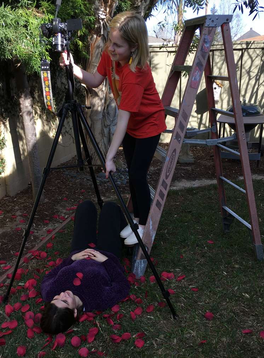 Every year, HB Academy of the Performing Arts' MMET program holds their famed Playlist show, which features student musicians and singers performing some of the most popular songs of the year and some original songs as well, working in collaboration with the MMET Media students who specialize in film and live TV Production. Both MMET Popular Music and MMET Media majors are able to combine their talents during this time as the annual shows provide the opportunity for music videos to be made for the original songs, all created and produced by the students. Faith Longo, a senior in the MMET program, recently had her original song "Backwards" produced, getting it featured in the Playlist 2018 show along with an original music video directed by Grace Larey, a junior in MMET. I interviewed Faith about the creation of her song, the production of her music video, and her experience as a musician and writer. Faith Longo: Vocalist and Guitarist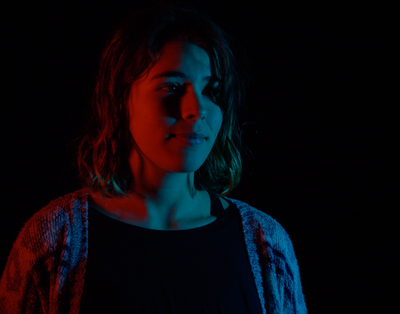 Caitlyn: How did your song “Backwards” evolve since its first chords to its final edit? Faith: Like pretty much every song I write, “Backwards” was created because of a major event in my life. I always start with a feeling, and then try to emphasize it with the chords I use. Plus, I’ve always really loved poetry, so the lyrics for “Backwards” came mostly out of a small poem I wrote a few days prior. Unlike most of my songs, I tried to first create it on piano, which I think is why it took me over 5 months to really finalize it; it never really felt right. Around November I finally went back to it and tried again on guitar instead, and that’s when I really had that “yes!!! This feels right!!!” moment. I met up with Atreyu I think the very next day; he suggested the strumming pattern and helped add bass, which made the song sound a lot fuller. Honestly though, my favorite part of the whole process was probably making harmonies. I’m not the strongest instrumentally, so adding those harmonies was like adding my own little flare. After all that, Simmons got to mixing and added more electric guitar, drums, and percussion which helped make my song really come together. Everytime he sent me a new mix it was like opening up a Christmas gift. Not only that, but Simmons incorporated the super groovy reverb effects to give my song a ‘backwards’ effect (HAAaaaa). I’m so so grateful for Simmons, I don’t think my song would’ve had nearly as much impact if it wasn’t for all that he did. C: Who was involved in the creation of your song? F: Atreyu is usually the first person I go to to get critique on what I’m writing. He’s my best friend and so incredibly talented so I know I can always trust him. I had my good friend, Denise, record vocals on the song too since her voice blends so well with mine. Simmons did the most with my song though. He helped bring out and emphasize every feeling, and it was super cool collaborating and using the ideas that he had along the way. C: What was your experience filming your music video like? What is it like to watch film and your song merge together? F: Filming my music video was so cool! I loved collaborating with Grace, Drake, and Chase on new ideas. Not gonna lie, I have a low tolerance for cold already, so some scenes were pretty hard to shoot. I’d have to sing and try my best to seem calm and warm despite my teeth begging to chatter. But it was all so worth it once I saw the final product. It was incredible seeing everything come together so perfectly. I felt like the video really complimented the tone of the song, and it was able to visualize the message in a new way it would have never been able to just on its own. They even put in little details to highlight some of the lyrics! Overall, they all did such a great job on the video, and I feel like it fits so well with the song. I also really appreciate Drake for having the courage to get into freezing cold water with me, he’s a true homie. Holly Olmos directed the music video for Olivia Castagna's song "Things Don't, They Just" in preparation for the HB Academy of the Performing Arts' MMET Playlist 2018 show. 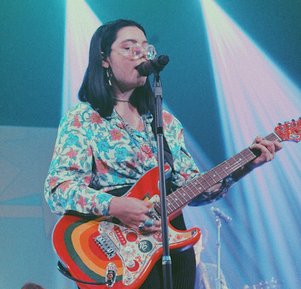 The art of the music video is one that is intriguingly unique. Music videos are able to combine the magic of song and film into one piece of artwork, with an innumerable amount these videos being created and shared throughout the past many decades. While the platform is undeniably popular, creating a cocktail of two art forms can take a lot of work, effort, and creativity. That's why we decided to take a look into the production of high school students Holly Olmos and Olivia Castagna's music video "Things Don't, They Just." Olivia Castagna, a high school senior who specializes in vocals and guitar, wrote the song over a period of time and the final song was admitted to be performed in HB Academy of the Performing Arts' MMET Playlist 2018 show, which features a number of talented students performing both originals and the most popular songs of the year. The MMET Popular Music branch, which Olivia is a member of, collaborates with the MMET Media branch each year to create music videos for the admitted original songs in the show, which inspired the creation of Olivia and Holly's music video. Holly Olmos is also a senior in high school, who is a member of MMET Media, who specializes in filmmaking. Holly and Olivia had previously worked on a music video for Playlist 2017, and continued their partnership for the most recent show. In interviewing the two of them, I was able to take a deeper look into what it took to create the music video for "Things Don't, They Just" and find out more about each individual growing artist. 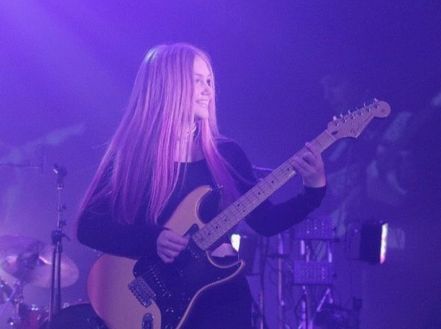 The Heart2Art Project's president Caitlyn Phu talked to Alana Johnson, a 15 year old musician, about her experience as a creator, the artists that inspire her, the role of women in music, and more. Here's what she had to say: Caitlyn Phu: What is your passion and when did it begin? How did it develop and grow throughout your life? Alana Johnson: I wouldn’t define my passion as anything except creating. I create music, films, stories, screenplays, concepts, movement, and paintings. Even though I feel like all of these art forms are calling out to me, music screams the loudest. When I was four years old, I received my first songbook, and I would say that’s when my creativity truly began. I asked my dad how many songs an album typically had, and he told me around 14-17. I worked on and then completed 20 over the next four months and told my dad when I finished. Shocked, he asked to hear them all. I can still remember them and how shit they were, but, since then, it has only grown and changed. Eighth grade was the year I decided I wanted to be a musician. The year before was extremely rough and nothing I did interested me. I wasn’t enjoying anything, so I began to just practice guitar in my bedroom all day after school, and that gave me purpose. My guitar pushed me to do better, it motivated me, it comforted me. Writing music is like my therapy, and I find comfort in the fact that no matter what happens to me, I can lean back on my guitar. CP: What aspect of music interests you the most and why? Why is it important to you? AJ: I think that music is so important to me because it connects me to a higher power. I don’t know why we are here, but who or whatever put us here gifted us with this sound that makes us feel emotions whether it be pleasure or sadness or fear. Take the time to think about what music really is: just a connection of sounds that your brain associated with happiness or nostalgia, really. It’s incredible. I think, for me, my passion has a lot to do with performing. When I used to do theatre and dance, it wasn’t really the activities I enjoyed, just the energy of the performance. The first time I performed music, my guitar teacher was doing a showcase where all his students got to play two songs in a bar. He was always impressed with my originals and asked me to play one for the showcase. Playing my music in front of other people for the first time was terrifying, but was the happiest I've ever been. I’ll never stop chasing that feeling. 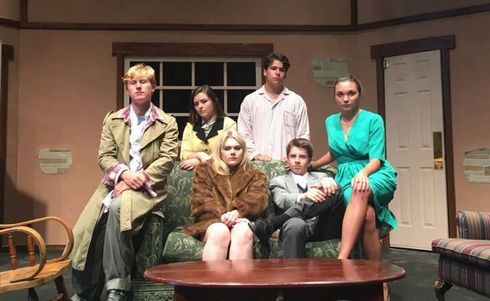 The Heart2Art Project's president Caitlyn Phu interviewed Kaylie Flowers, a 16 year old performer living in Huntington Beach, about her experience as a theatrical performer and artist. Here's what she had to say. Caitlyn Phu: What is your passion and when did it begin? How did it develop and grow throughout your life? Kaylie Flowers: My passion is theatre. I started theatre when I was in the 5th grade after my dad had randomly brought it up. I had no friends at the time and was getting bullied at my elementary school, so I felt like maybe I could make some friends there and just do [theatre] to escape. I remember standing in a circle in a small, dingy warehouse and just watching all these pre-teens let loose, leaving the drama outside. After a year [of practice at the theatre], I did a show; the lights, the comradery, and a different attention was what called me to the stage. From then on, I did more improvisation shows and plays and, when I had moved middle schools, I did more plays there. I knew that I wanted the stage as soon as I heard the first applause. Now, it’s all I do and I’m trying to make it my future. CP: What aspect of theatre interests you the most and why? Why is it important to you? KF: I love being someone else. I love the costumes, accents, hair, and culture that I can be sucked into by just reading lines. It’s important to me because it’s something I’m good at. I’m not great at math or economics, but, in theatre, that doesn’t matter. An, honestly, [I value] the attention. When I was bullied, they focused on my look and on my low self confidence. However, when I’m on stage, it’s a fixation on my talent. It’s a nicer attention. CP: What kinds of obstacles did you face in pursuing the arts, either as a hobby or career? Did you have any supporters along the way? KF: I face obstacles constantly. Mostly rejection for roles, and that’s normal, but actors should be cast based on talent and not on pressure [from outside expectations]. For film roles, the case is the color of my skin, but now that I’m going for ethnically ambiguous, it’s easier. I love my supporters. I consider some of them family. They’re mostly my mom, dad, some friends, and past/current directors that have given me great notes on how to expand my career. CP: What similar artists inspire you and why? KF: I try not to aspire to be anyone else because I’ll focus on them and their methods and try to be like them. Sure, I’ll admire their talent, but I don’t want to be known as a copy of someone because, then, who would I be? Every actor is so individually different and that is what is so great about acting. I adore the whole cast of The Office, so much so that I met Rainn Wilson and have his book. The writing and reactions in that show are so real and genuine it feels like they are at an actual office. Also, [I am inspired by] the women of SNL, because they are such polished improvisers that they can literally become anyone. Kate McKinnon, Kristen Wiig, Amy Poehler, and Tina Fey, to just name a few, are gold plated comedians, along with Will Ferrell and many more. CP: Throughout history, the arts have been perceived as an extremely male-dominated practice, and an absence of recognition for women’s role in the arts has led to a lack of opportunity and acknowledgement for females in the arts today. Has this impacted your pursuit of the arts? What would you like to see change? KF: Yes! Men will always be precast when it comes to small theatre. Currently, we are in need of more guys in theatre. Because boys are scared of being called derogatory terms [in theatre], men don’t care about the theatre. For women, it’s more competitive. Freshman year, at callbacks for Antigone, I got called a “whore” in front of the everyone because I didn’t want to kiss a boy. Rather than staying quiet and letting him get away with that I told him off in front of everyone, even the director, which could have really ruined my chances at getting the role. However, because I stood up to him, I landed the role. Additionally, there needs to be more leading female minorities. That’s a change I want to see, especially seeing more lead characters that are a color other than white, more women who aren’t cast as a sex symbol or a damsel in distress, and female directors that aren’t criticized for making films that are “too feminist.” CP: Why do you think it is important to recognize and give opportunities to more female artists? KF: Art inspired art. Women should be considered just as qualified and talented because they are, it shouldn’t be based off of if I have a penis or not. This also goes for anything out of the business as well. If a women does better work than a man, has a child, and pays for her house, she should be recognized as equal not at submissive or “ too emotional.” Just shut up already, you’re just as emotional as a girl too. CP: What impact do you wish to make with your art? KF: I want to inspire. I want people to see me and think, “Hey, if that brown girl with that body can do it, so can I.” CP: Is there anything else you would like to say or share? KF: Being a teen, it is harder for me to answer these questions because, although I’m experienced for these years, college and the industry is going to bring up new obstacles that will both trip me up but also push me forward. Follow Kaylie! Instagram: @kaylie.flowers Twitter: @kaylie_flowers |
